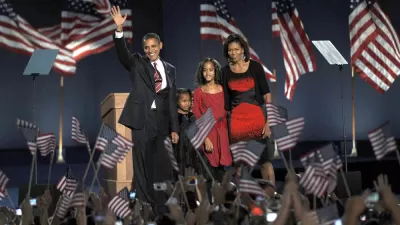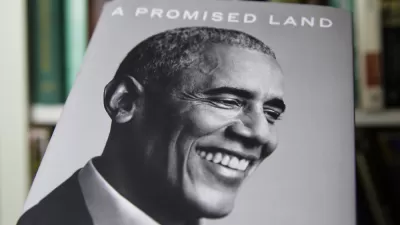According to the architecture critic for the Chicago Tribune, the Obama Presidential Center is still falling short of the iconic status that can serve as a landmark for the South Side of Chicago.

Blair Kamin shares insights and commentary on newly released, updated designs for the Obama Presidential Center planned for the South Side of Chicago.
The first version of the Obama Presidental Center’s museum tower, unveiled in 2017, was heavy and funereal, like a truncated Egyptian pyramid.
Version two, which emerged last year, was taller and less severe, with screenlike walls of letters and a lighter-colored stone. But it was still pretty massive and intimidating. Former President Barack Obama told the architects to make it more welcoming and to give it a more interesting and engaging form, they said in a telephone interview Saturday.
Since being announced in March 2017, the Obama Presidential Center has been criticized for potentially displacing local residents and not closing an adjacent street to car traffic, and has encountered at least one legal setback and questions about the need for a community benefits agreement.
With that history as context, Kamin writes that version three of the design for the Obama Presidential Center is an improvement, but an incomplete effort.
The design, by New York architects Tod Williams and Billie Tsien, is considerably improved, especially on its main, south-facing front. But the tower has yet to become a compelling object — or icon, to use the currently overused word — from all sides.
The good news, according to Kamin, is that the design is still evolving, and there's time for further changes. Also, "the federal review of the center’s impact on Jackson Park won’t be done until early next year, so ground won’t be broken until then."

Planetizen Federal Action Tracker
A weekly monitor of how Trump’s orders and actions are impacting planners and planning in America.

Maui's Vacation Rental Debate Turns Ugly
Verbal attacks, misinformation campaigns and fistfights plague a high-stakes debate to convert thousands of vacation rentals into long-term housing.

Restaurant Patios Were a Pandemic Win — Why Were They so Hard to Keep?
Social distancing requirements and changes in travel patterns prompted cities to pilot new uses for street and sidewalk space. Then it got complicated.

In California Battle of Housing vs. Environment, Housing Just Won
A new state law significantly limits the power of CEQA, an environmental review law that served as a powerful tool for blocking new development.

Boulder Eliminates Parking Minimums Citywide
Officials estimate the cost of building a single underground parking space at up to $100,000.

Orange County, Florida Adopts Largest US “Sprawl Repair” Code
The ‘Orange Code’ seeks to rectify decades of sprawl-inducing, car-oriented development.
Urban Design for Planners 1: Software Tools
This six-course series explores essential urban design concepts using open source software and equips planners with the tools they need to participate fully in the urban design process.
Planning for Universal Design
Learn the tools for implementing Universal Design in planning regulations.
Heyer Gruel & Associates PA
JM Goldson LLC
Custer County Colorado
City of Camden Redevelopment Agency
City of Astoria
Transportation Research & Education Center (TREC) at Portland State University
Jefferson Parish Government
Camden Redevelopment Agency
City of Claremont





























